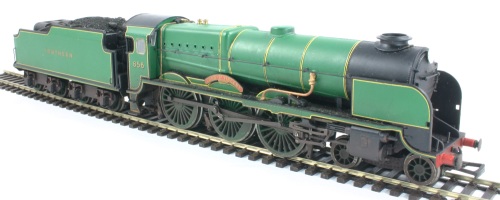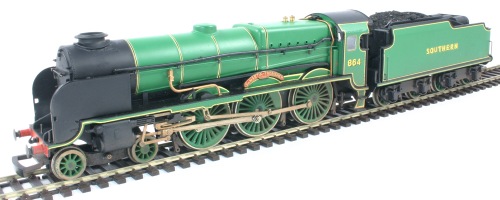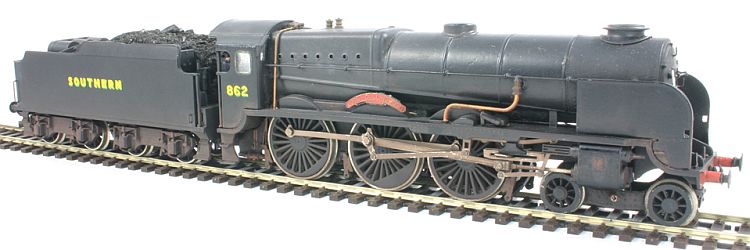Review of the Bachmann Branchline Blue Riband Lord Nelson class

Class leader -Nº850 Lord Nelson. image courtesy of Bachmann |
Introduction:First introduced by Bachmann in 1992 their model of Maunsell's top passenger express locomotive was a regular in their catalogue up until 2002 after which it has only appeared again in 2008 and 2009/10. Despite the gap in production and the progress of other models in the interim the model has not been retooled in anyway, only the coupling has been changed for the newer slim line type (but not in NEM pockets). The latest 2009/10 release has a better finish to the Brunswick Green and finer lining.Although one of the more detailed models when first introduced, it is now showing its age to a certain extent as the bar has continually risen over the last few years with ready to run models such as the Bachmann N and Hornby's Q1, M7, T9, Schools and N15. Due to the chimney being a separately applied component, effectively two basic body styles have been issued to
date, firstly with original Maunsell style chimney and secondly with a representation of a Bullied Lemaitre
Chimney. Both versions have the flat fronted middle cylinders due to slightly longer smokebox as modified by
Bulleid commencing in June 1939. The chassis is of the original Bachmann die cast split chassis design which although fitted with a large 3 pole can motor provides smooth and powerful running. Pick ups are via the main driving axles only, neither the font pony truck (also fitted with split axles, which can be prone to coming apart) or tender wheels are fitted with pick ups. The wheels on the front pony truck also have quite thick and obvious side rims and the lack of cylinder drain pipework also accentuates this fact. The rim sides benefit from the addition of a little paint (although on the latest release these rims and those of the main driving wheels have been chemically blackened). The detailing on the model when compared to today's expected standards is average with moulded smokebox lamp irons and on the tender rear. The locomotive front steps are missing from the model, however tender steps are provided for the purchaser to fit although due to the tender length issue the rear tender steps can impede the minimum radius that the model will transverse as they will foul the rear bogie movement. It should also be noted that for on some of versions of 31-407Nº856 in Bulleid Malachite the lettering and number decals are in gold rather than yellow although the lining is correctly yellow. |
 |

photographs by Graham Muspratt |
| N.B. Please note that Graham's models have had replacement chimneys, weathering and in the case ofNº862 has been repainted into wartime black. |
A number of simple improvements can be made to the model to improve its look and update it a
little:
|

photograph by Graham Muspratt Text from Graham Muspratt. |
Bachmann Lord Nelson Class variations
return to model railway product reviews index
This page was created 24 September 2011